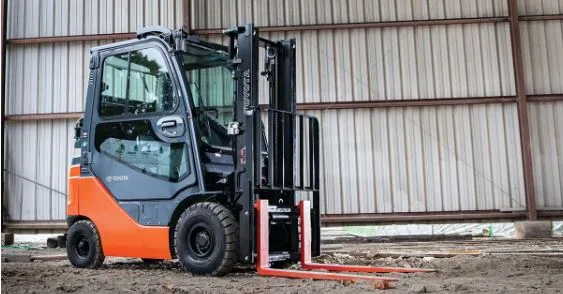What Should You Look for in a Used Forklift?
The Ultimate Used Forklift Buying Guide
When it comes to purchasing heavy equipment for your warehouse, construction site, or logistics operation, buying new isn’t always the most cost-effective solution. A used forklift can provide years of reliable service at a fraction of the price of a new model. But how do you make sure you’re getting a good deal—and not a machine that’s going to cost you more in repairs than it’s worth?
This comprehensive used forklift buying guide walks you through the most important things to check before making a purchase, ensuring that your investment is smart, safe, and long-lasting.
Why Consider a Used Forklift?
Before diving into what to look for, it’s worth asking: why buy used in the first place?
- Cost Savings: New forklifts can cost anywhere from $20,000 to $45,000. Used models are often half the price.
- Depreciation Advantage: Like cars, forklifts lose the most value in their first few years. Buying used lets someone else absorb that initial depreciation.
- Availability: If you need a forklift fast, used options are often ready for immediate delivery, while new ones might involve long lead times.
- Variety of Options: The secondary market often includes models that may no longer be in production but are well-loved for their durability.
That said, the savings only pay off if you know what to look for—and what to avoid.
Step 1: Define Your Needs
Every forklift has different capabilities, and not every model is suited for every job. Before browsing used equipment, clarify:
- Load Capacity: What’s the heaviest load you’ll need to move? Overloading a forklift shortens its lifespan and is a major safety hazard.
- Lift Height: Do you need to reach high warehouse racks or just move pallets at ground level?
- Fuel Type: Electric, propane, diesel, and gas forklifts all have pros and cons depending on your environment.
- Operating Environment: Will the forklift primarily work indoors, outdoors, or both?
- Usage Frequency: A lightly used forklift may be fine for occasional use, but if you need daily heavy lifting, a sturdier model is worth the investment.
Knowing your requirements helps you avoid buying more (or less) machine than you actually need.
Step 2: Inspect the Forks and Mast
The forks and mast are the heart of any forklift, and wear here can indicate how hard the machine has been used.
- Check the Forks: Look for cracks, bends, or uneven wear. Fork thickness should not be more than 10% thinner than the original spec.
- Inspect the Mast Chains: Ensure they move smoothly without jerking or sticking. Rust, kinks, or missing links are red flags.
- Hydraulics: Raise and lower the forks to check for smooth operation. Look for leaks in the hydraulic lines or cylinders.
If the mast jerks or the forks seem unsteady, walk away—it’s a sign of deeper mechanical issues.
Step 3: Evaluate the Engine or Motor
A forklift’s power source is one of the most expensive components to repair or replace.
- Internal Combustion Engines (Propane, Gas, Diesel):
- Check for leaks under the machine.
- Listen for unusual knocking or grinding noises.
- Inspect oil, coolant, and transmission fluid for proper levels and clean condition.
- Electric Motors:
- Ask about the age of the battery—most last 5–7 years.
- Inspect the battery compartment for corrosion or acid leaks.
- Check charger compatibility.
A thorough engine inspection can make the difference between a bargain and a money pit.
Step 4: Review the Tires and Undercarriage
Forklift tires aren’t just about traction—they also affect stability and load capacity.
- Solid Tires: Look for chunking, tearing, or flat spots.
- Pneumatic Tires: Check for proper inflation, sidewall cracks, and tread depth.
- Undercarriage: Inspect for rust, cracks, or damage to the frame. A bent frame can render a forklift unsafe and nearly impossible to repair.
Replacing tires is common, but damage to the undercarriage is a dealbreaker.
Step 5: Inspect the Operator’s Compartment
Operator comfort and safety are essential, especially if the forklift will be used daily.
- Seat and Seatbelt: Ensure the seat is intact and adjustable. A working seatbelt is non-negotiable for safety compliance.
- Controls and Pedals: Test the steering, brakes, accelerator, and hydraulic controls. They should respond smoothly without sticking.
- Dashboard: Check that warning lights and gauges work properly.
- Visibility: Sit in the seat and test your line of sight—good visibility reduces accidents.
A well-kept operator’s area is often a sign of good overall maintenance.
Step 6: Look for Signs of Wear and Tear
A used forklift will naturally show some wear, but certain signs indicate abuse or neglect:
- Rust or Corrosion: Especially around joints, frame, or hydraulic cylinders.
- Weld Repairs: Poorly done welds may suggest structural damage.
- Paint Condition: While scratches are normal, inconsistent paint may indicate parts replacement after an accident.
- Hour Meter Reading: Like mileage on a car, forklift hours matter. Under 10,000 hours is generally good; over 20,000 can be risky without proof of major maintenance.
Step 7: Ask for Maintenance Records
Documentation is your best friend when buying used. Ask for:
- Service Logs: Regular oil changes, hydraulic checks, and inspections indicate responsible ownership.
- Repair History: Major repairs are not necessarily bad—if done professionally, they can extend lifespan.
- Accident Reports: These may reveal whether the forklift has been rolled, tipped, or overloaded.
A seller unwilling to provide records should raise a red flag.
Step 8: Test Drive Before You Buy
Never finalize a purchase without putting the forklift through its paces. During your test:
- Drive forward and in reverse—check for smooth gear shifts.
- Test brakes under a load and without.
- Turn sharply to check steering response.
- Raise and lower the forks repeatedly.
- Listen carefully for unusual noises.
A test drive tells you more than any sales pitch ever could.
Step 9: Verify Safety Compliance
Regulatory compliance isn’t optional—it’s the law. Make sure the forklift includes:
- Overhead Guard: Protects operator from falling objects.
- Load Backrest: Prevents materials from falling toward the operator.
- Working Lights and Horn: Required for visibility and communication.
- OSHA/ANSI Safety Labels: Indicating the forklift meets current safety standards.
An unsafe forklift is not just a liability—it’s a potential lawsuit waiting to happen.
Step 10: Consider Dealer Reputation and Warranty
Finally, where you buy matters just as much as what you buy.
- Authorized Dealers: More likely to have properly reconditioned forklifts.
- Independent Sellers: May offer lower prices, but vet carefully.
- Warranty Options: Even a short-term warranty can give you peace of mind.
- Return Policy: Clarify whether you can return the machine if it fails inspection after purchase.
Choosing a reputable source reduces the risk of costly surprises.
Common Mistakes to Avoid
Even seasoned buyers sometimes make costly errors when shopping for used forklifts. Avoid these pitfalls:
- Skipping the Test Drive: Never rely on a visual inspection alone.
- Ignoring Load Requirements: A forklift that can’t handle your heaviest load is useless.
- Overlooking Hidden Costs: Delivery, parts, tires, and battery replacements can add up.
- Trusting Without Verifying: Always demand records and confirm safety compliance.
The Bottom Line: Make an Informed Choice
A forklift is an investment in your business’s productivity and safety. Cutting corners might save money upfront, but it can lead to costly downtime or accidents later. By following this used forklift buying guide, you’ll know exactly what to look for—from forks and hydraulics to safety features and service records.
The goal isn’t just to find the cheapest forklift—it’s to find the one that will serve your business reliably for years to come.
Final Checklist: Your Used Forklift Buying Guide at a Glance
- Define your lifting capacity, height, and environment needs.
- Inspect forks, mast, hydraulics, and chains.
- Evaluate the engine, battery, or motor health.
- Check tires and undercarriage for damage.
- Review the operator’s compartment for safety and comfort.
- Look for signs of excessive wear or abuse.
- Request full maintenance and repair records.
- Always test drive before purchase.
- Verify OSHA/ANSI safety compliance.
- Buy from a reputable source with warranty or return options.




